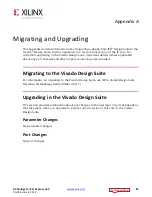
AXI Bridge for PCI Express v2.4
72
PG055 June 4, 2014
Chapter 4:
Design Flow Steps
All BAR registers share these options:
•
Checkbox
: Click the checkbox to enable the BAR; deselect the checkbox to disable the
BAR.
•
Type
: BARs can be Memory apertures only.
°
Memory
: Memory BARs can be either 64-bit or 32-bit. Prefetch is enabled for
64-bit and not enabled for 32-bit. When a BAR is set as 64 bits, it uses the next BAR
for the extended address space, making it inaccessible.
•
Size
: The available Size range depends on the PCIe® Device/Port Type and the Type of
BAR selected.
lists the available BAR size ranges.
•
Value
: The value assigned to the BAR based on the current selections.
For more information about managing the Base Address Register settings, see
Base Address Register Settings
.
Managing Base Address Register Settings
Memory indicates that the address space is defined as memory aperture. The base address
register only responds to commands that access the specified address space. Generally,
memory spaces less than 4 KB in size should be avoided.
Disabling Unused Resources
For best results, disable unused base address registers to conserve system resources. A base
address register is disabled by deselecting unused BARs in the Vivado IDE.
PCIe Miscellaneous
The PCIe Misc screen is shown in
Table 4-3:
BAR Size Ranges for Device Configuration
PCIe Device/Port Type
BAR Type
BAR Size Range
PCI Express Endpoint
32-bit Memory
128 Bytes - 2 Gigabytes
64-bit Memory
128 Bytes - 8 Exabytes
















































